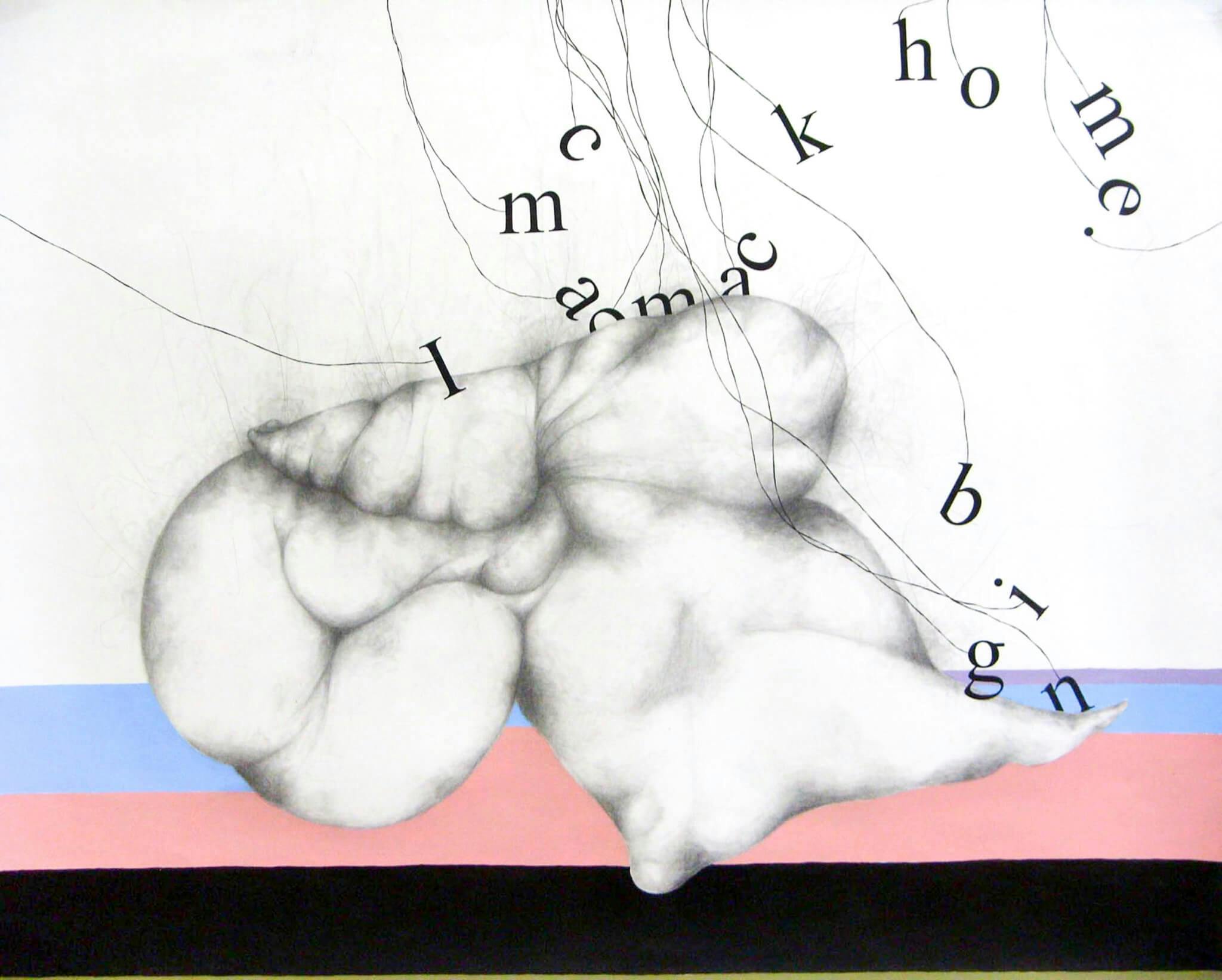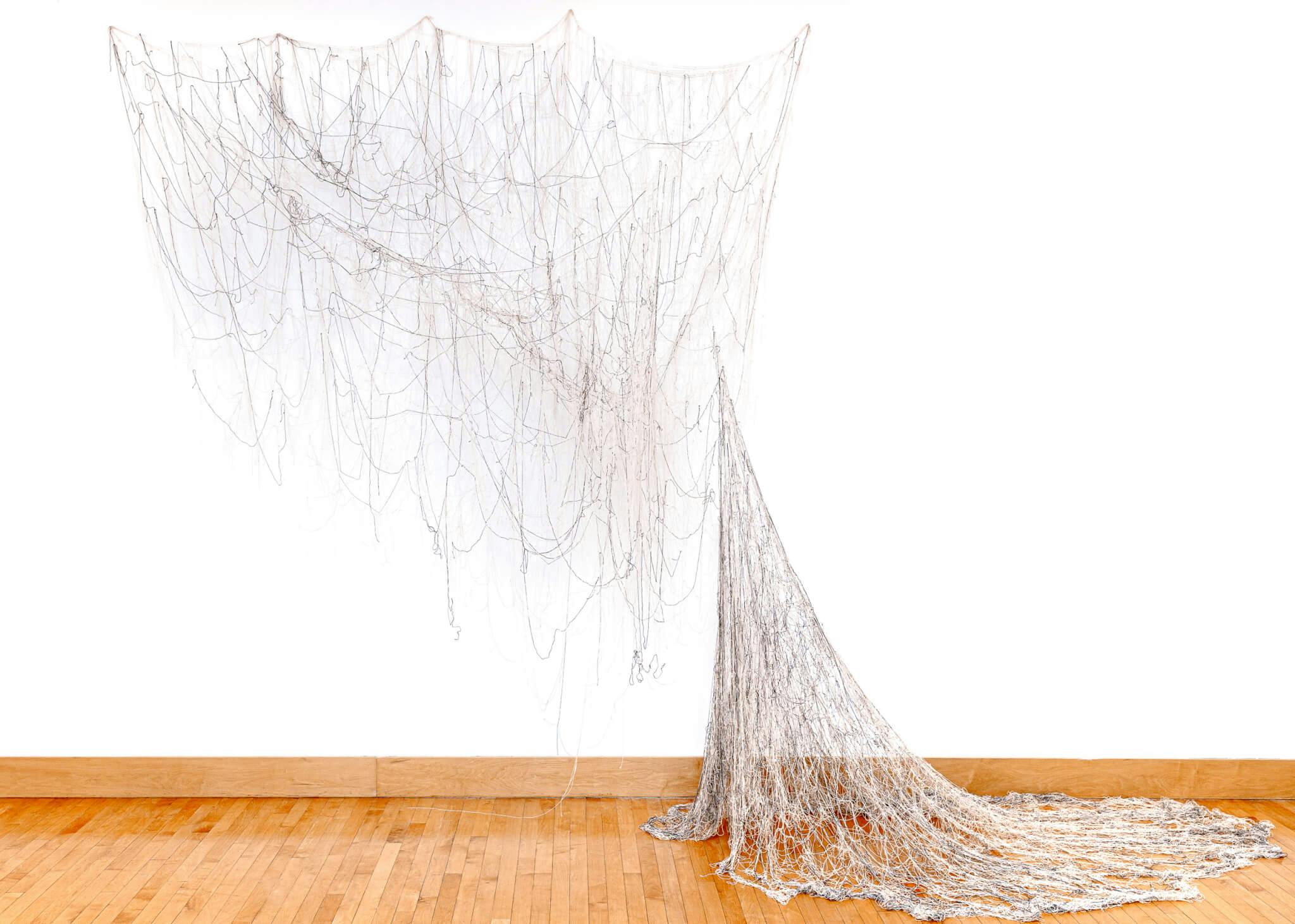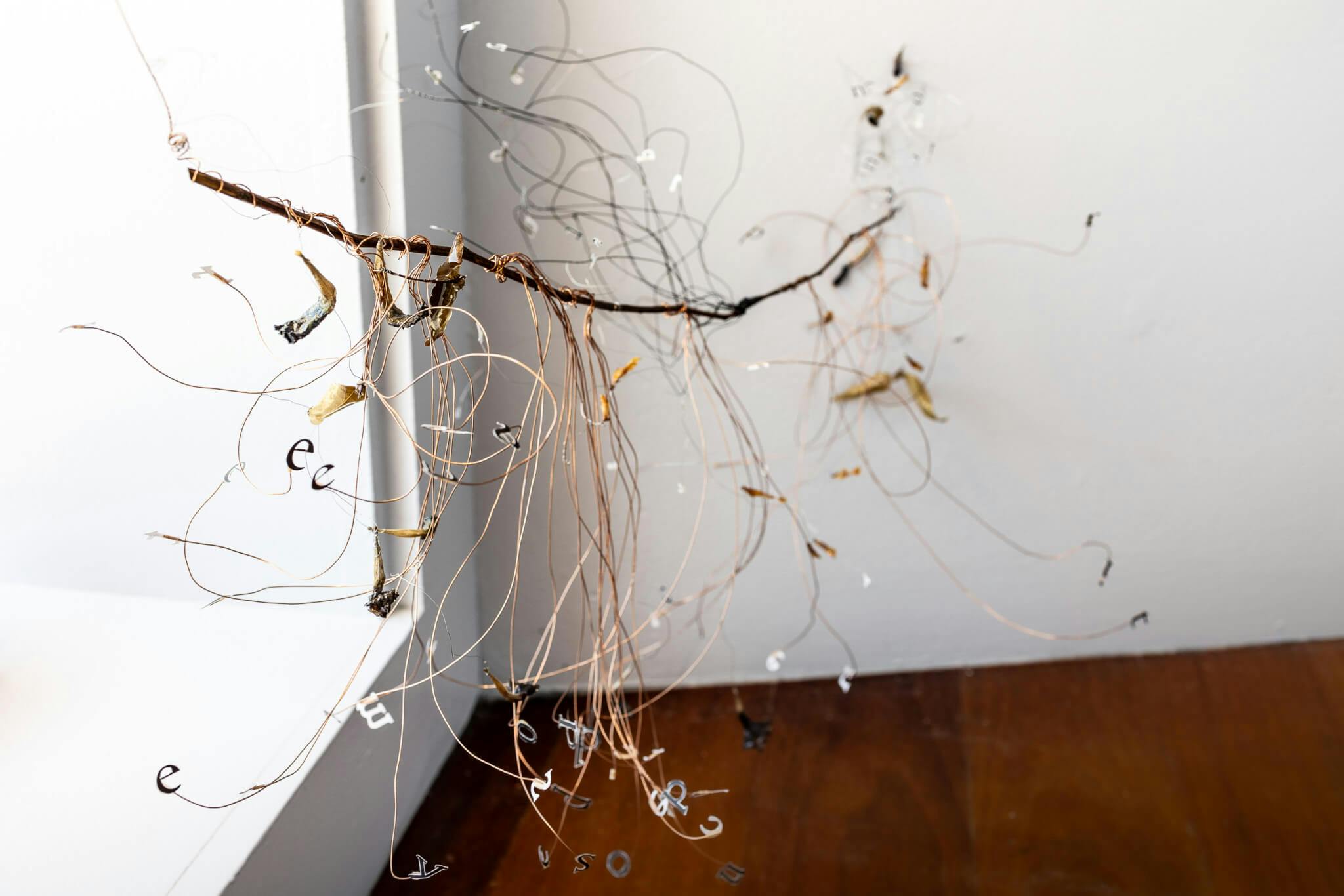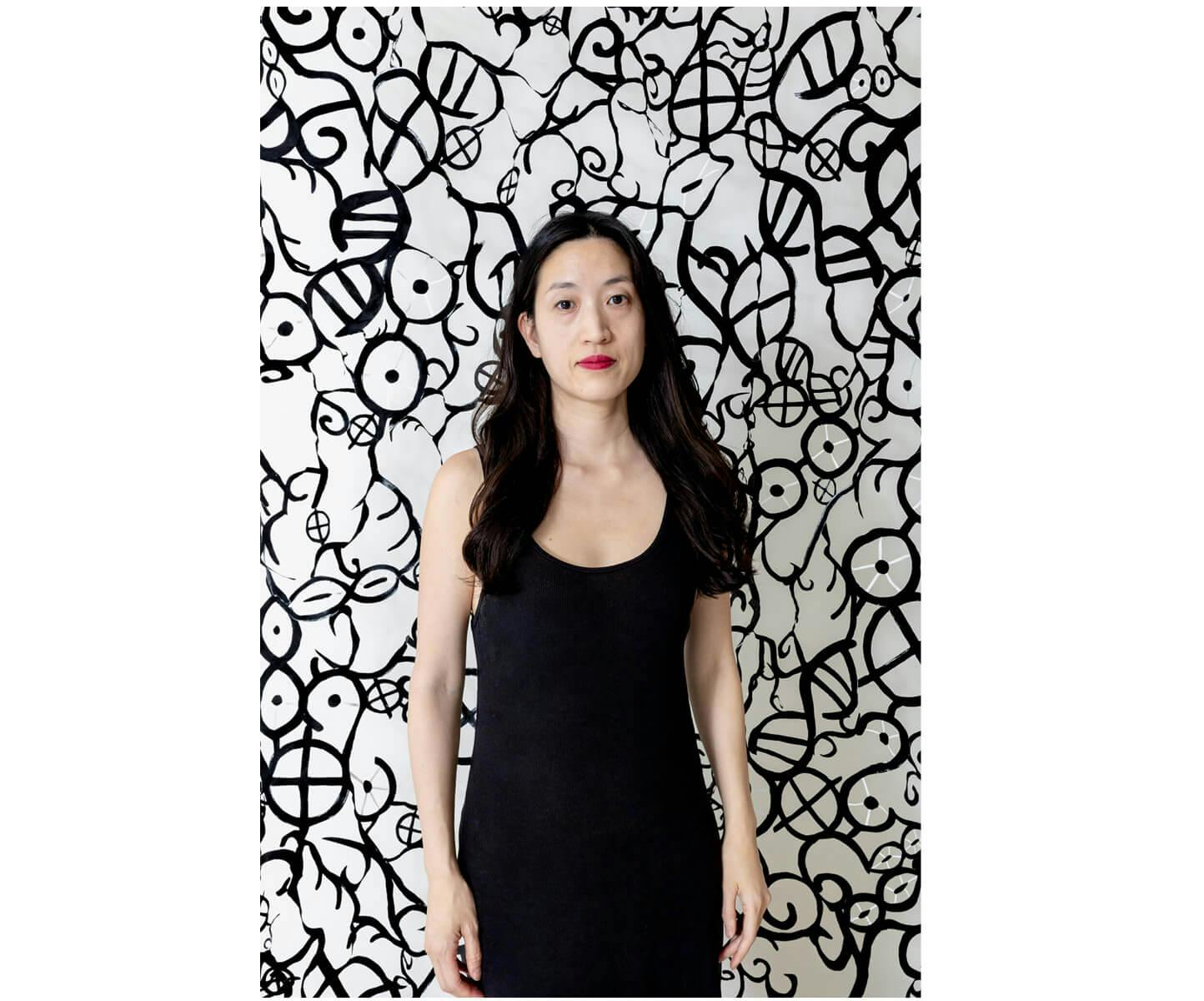This fall, Boston- and Taipei-based artist Jocelyn Shu has had work on view in three exhibitions in the Greater Boston area (two of them are still on view through early November), all of which showcase her exploration of the fluidity and complexity of languages and emotions. She often takes things apart and puts them back together in new ways, much like the constant translating process that emerges as people move between spaces and cultures.
On view through November 5 in the LaunchPad space of Boston Sculptors Gallery, “As I Came Home” is Shu’s first solo show in Boston and features work she created while living in Cambridge, Taipei, and New York City. Walking into this long, narrow space, visitors enter a playful universe of sculptural works protruding elegantly from all corners of the space. The installation includes pieces from her ongoing project 81 Chapters, a body of work through which she transforms chapters of Dao De Jing, a Chinese philosophical work, into sculptures made of cut text, wire, and found natural objects. Some of them are installed as wall pieces, like a torso standing in the air, and some are placed on the floor, like grass growing out of the cracks between rocks. When you walk past the delicate and intricate sculptures, they sway gently in the air; it’s almost as if they are whispering in your ears. With sunlight coming in from the window, everything in this intimate space feels full of energy.
While Shu has been fully working in 3D in recent years, she has a background in painting and drawing. In her early artistic career, she mainly explored the use of abstraction and representation in works on paper and canvas and made a lot of self-portraits in an intimate space such as her home and studio.
Even though her 3D works today look drastically different from her earlier 2D works, it is not hard to find signs of an early interest in the dialogue between representational work and abstract languages. She started to incorporate text in fractured ways even over a decade ago, as evidenced in Homage (2011). As her focus shifted to the structure and physicality of the canvas, she began to regard painting more as a sculptural form and eventually turned to making sculptural works after starting her PhD in psychology studying emotions. I caught up with Shu on occasion of her recent and forthcoming exhibitions to discuss the materiality of her practice coupled with the cerebral and representational ways language appears in her sculptures and paintings.
The following conversation has been edited and condensed.

Jocelyn Shu, Homage, 2011. Graphite, acrylic, collage, and ink on paper. 32’ x 40’. Photo courtesy of the artist.
Yutong Shi: What is your relationship with painting, and how do you see paintings as objects?
Jocelyn Shu: When I make sculptural forms, I feel very much as if I am drawing and thinking in 2D—creating lines that travel through air and space. After I graduated from college, I was struggling to figure out who I was as an artist. I was drawn to the physicality of the painting canvas and was working larger and larger. As I built my own canvases—a more economical strategy than buying premade canvases—the structure of the canvas became more symbolic, with the canvas stretched over wooden bars evoking that of skin and skeletal frame to me. Having grown up in the Bay Area amidst rich discourse on Asian American identity, it is impossible for me to not see the significance of painting over raw canvas with white gesso. I considered painting as a distant observer—as a medium in which its physical structure could be in dialogue with representational and abstract languages spoken with paint.
YS: How did you eventually move from painting to sculpture?
JS: With the structure of the canvas being important in my work, I eventually thought of painting as a sculptural form. While painting for me has dealt with the body, working with drawing, paper, and text has dealt more with the mind. So there was this impetus for working in three-dimensional space. But it wasn’t until several life transitions later that I made the jump to working fully in 3D.
By then, I had moved to New York City and had begun working as an academic researcher in psychology. Perhaps all these changes and transitions had propelled me to work in a different medium. Either by coincidence or not, I started to fully work sculpturally with text and wire—language and line—when I started my PhD in psychology.

Jocelyn Shu, Canvas, 2023. Unraveled 37’ x 62’ canvas, ink. Dimensions variable. Photo courtesy of the artist.
YS: Can you speak about your work Canvas (2023) that is currently on view at Merrimack College? It is such an interesting sculptural piece made from canvas. It seems like you are engaging with material that you worked with a lot in your early artistic career. We normally don’t see the presence of the canvas behind layers of paint, not to mention noticing the thread that made the canvas. But in this piece, you pull threads apart and lay them out front for us to see.
JS: I started this in Taipei while reflecting on how to reengage with painting after working sculpturally for over a decade. Living in Taiwan has been my first time living in a non-Western society. It was very interesting to see Western-style paintings with oil on canvas through this lens of something artists in this region during the modern period had been trained in—this lens of viewing Western painting as the “other” instead of the default.
I created this piece by unraveling a piece of raw canvas, thread by thread, and dipping some of the threads in ink. During this process of unraveling, I realized there were two distinct parts to the piece: the horizontal weft threads I was pulling out and the remaining warp threads that had supported the canvas. I tied the threads back together—with the weft threads hanging down from the wall and the supporting warp threads reaching up from the ground. I wanted the final work to reflect these two components, once woven together and now separated. This piece feels significant for me in that I am now thinking about the painting canvas again—the connotations of this material melding with lines drawn through space.
YS: You moved to Taipei earlier this year and call it “your other home” now. After returning to Boston, where you have lived and worked for four years, you opened a solo show in the LaunchPad space at Boston Sculptors Gallery. It is titled “As I Came Home.” Did you come up with this title? What does “home” mean to you?
JS: It is so interesting that you picked up on that. I would have never thought to refer to Taipei as my home before, and now I do so without realizing it. When I first moved to Taiwan, my parents in the Bay Area decided to visit Taiwan also, as it had been a while since they had been back due to the pandemic. It was a revelation to hear my parents recall stories from their past of places we would pass by, to go to my mother’s favorite steamed bun food stall when she was a child (now run by another generation), and to experience the fact that my family had a history in this place. I simply did not have this experience in the US as my parents immigrated to the US and I had taken it for granted that they started new lives in this country. I think there is something deep about the feeling that you are in a place where you have roots. I don’t think it is simply a matter of having family history in a place though.
With “As I Came Home” being my first solo show in Boston, I wanted to center it around the work I created here. I turned to Thoreau’s Walden, which I had found to be particularly resonant with the intellectual atmosphere in this area, and took the opening words from the chapter “Higher Laws”—a chapter reflecting on human nature. The phrase “As I Came Home” seemed a fitting title in the context of my current travels between geographies, cultures, fields of knowledge, and homes.
YS: I went back to my hometown in mainland China this summer after five years of living abroad, and it actually felt very strange, though still familiar. I also tried to find places where I could recall stories. But what is interesting is that coming back to Boston feels more like home to me now.
JS: I commonly hear people living in Taiwan, who are not of Taiwanese heritage, express how they feel at home there too. I think underlying this is the feeling of community, belonging, and safety on individual and societal levels.

Jocelyn Shu, Chapter 17 (Parts I and II), 2021. Wire, cut text, glue, dried leaves and flowers in resin, tree branch. Installation dimensions variable (Part I: 30’ x 15’ x 12’, Part II: 60’ x 24’ x 12’). Installation view, “Jocelyn Shu: As I Came Home,” The LaunchPad at Boston Sculptors Gallery. Photo courtesy of the artist.
YS: You include multiple works from your ongoing project 81 Chapters in this show. Can you speak about how you started this series?
JS: I started this series over a decade ago when I began studying psychology. However, I had the idea for this project when I traveled to Taiwan right before moving to New York. In this sculptural series, I hand-cut text from translated chapters of this book, turning each chapter into a sculptural form. It has been a way to engage with the philosophical ideas of the text, which advocate for harmony with nature and adapting to change. This project also examines the act of translation and the limiting nature of language.
YS: It’s interesting to see the evolution within this series. In your recent pieces, we see the inclusion of objects from nature, such as leaves.
JS: When I moved to Cambridge for a post-doc at Harvard, I was inspired by the environment I was in and wanted to incorporate it into these pieces. I would collect leaves, branches, and flowers on my walks, then coat them in resin. I also started to use string to create geometrical lines in the work, which I thought of as referencing the linear thinking involved in science.
YS: In much of your work, you take things apart and put them back together. Text in your work becomes something else—less a language to read or understand, and more a visual form for people to observe and navigate within whatever context or culture they are coming from.
JS: This act of taking things apart and putting them back together in another form has been a consistent theme in my work. Perhaps it stems from the act of immigrating, relocating, and starting a new life in another culture. It is also there in the act of research and creation of knowledge.
YS: You grew up in a multilingual family. What is your experience with language?
JS: There is the constant translating between languages and cultures. I spoke Mandarin Chinese first, before learning English, as my parents spoke Mandarin at home. At some point, they thought it would be beneficial for my sister and me to primarily use English. My mother also speaks Taiwanese, a Chinese dialect spoken by the majority of Taiwanese who have a multigenerational history on the island—whose families had migrated there before the Chinese civil war and lived through the period of Japanese occupation. My father does not speak Taiwanese as his parents had arrived in Taiwan more recently, having migrated from China after World War II, during the civil war. My grandparents on my mother’s side spoke Japanese under the rule of Japan. They did not learn Mandarin until it was mandated by Chinese Nationalist forces when they took rule of Taiwan after retreating there in the civil war, implementing a new language system to replace that of the Japanese after the latter’s defeat in World War II. I remember my grandmother reverting to Japanese as she aged and lost her memory.
YS: It is fascinating to hear about all the different languages that have been used in your family. It reminds me of the Taiwanese films by Hou Hsiao-hsien, such as A City of Sadness (1989), which involves multiple dialects. A dialect is never simply a language one speaks; behind it is a long story of one’s family history, which oftentimes is very complicated in Taiwan with its history of political changes.
JS: There is so much deep history behind the use of language—on biological, historical, and cultural levels.
YS: Being both an artist and researcher, how does that change your relationship with or understanding of language?
JS: As a researcher, I learned to craft my thoughts with language. I think ideas often aren’t all that concrete until they are delineated through the arduous process of writing and editing. As an artist, there is something poignant about referencing language—this incredible skill that has enabled our species to record and share vast knowledge—yet acknowledging the limits of it.
Jocelyn Shu’s solo exhibition “As I Came Home” is on view at Boston Sculptors Gallery until November 5; “Messages for the Future” is on view through the end of October at Melrose Tiny Gallery. Her work can also be seen at “The Space Between Things” at the McCoy Art Gallery at Merrimack College in North Andover through November 17.




